We have heard terrifying stories from the revolution in Ukraine: anarchists participating in anti-government street-fighting behind nationalist banners, anarchist slogans and historical figures appropriated by fascists, a dystopia in which familiar movements and strategies reappear with our enemies at the helm.
This text is a clumsy first attempt to identify the important questions for anarchists elsewhere around the world to discuss in the wake of the events in Ukraine. We present it humbly, acknowledging that our information is limited, hoping that others will correct our errors and improve on our analysis. It has been difficult to maintain contact with comrades in the thick of things; surely it is frustrating to be peppered with ill-informed questions amid the tragedies of civil war.
What is happening in Ukraine and Venezuela appears to be a reactionary counterattack within the space of social movements. This may be a sign of worse things to come—we can imagine a future of rival fascisms, in which the possibility of a struggle for real liberation becomes completely invisible. Here follow our hypotheses and an English-language reading list on for those who are still catching up.
In each of the previous examples, initial police repression caused a single-issue protest to metastasize into a generalized uprising, transforming a square in the heart of the capital into a fiercely defended urban autonomous zone. This seemed to offer a new political model, in which people cohere around tactics rather than parties or ideologies. (It is telling indeed that Occupy was named for a tactic rather than a goal.) All these revolts could be broadly interpreted as reactions to the consequences of capitalism, though anti-austerity proved too narrow a frame: Turkey and Brazil saw protests over the effects of ascendant economies, not recessions. In any case, the majority of the participants have not described these movements as anarchist or anti-capitalist, framing them simply as grievances with specific governments and economic policies.
When photos began to circulate of the protests in Kiev, it’s not surprising that many in the English-speaking world assumed approvingly that these were part of the same phenomenon. Once again people were criticizing the government, occupying a central square, fighting the police. The specific organizers and demands had always seemed incidental—whether it was ¡Democracia Real YA! or Adbusters, the departure of a dictator or canceling a fare increase, we assumed that the important thing was the antagonism these upheavals facilitated against state control.

Occupy goes to hell.
Then we read in horror that nationalists and fascists were at the forefront of the confrontations and dominated parts of the organizing. Many reacted by disclaiming any connection, concluding that the events in Ukraine were simply a fake revolution funded and orchestrated from above.
But all the secretive manipulation in the world wouldn’t suffice to generate uprisings where there is no popular discontent. Comrades in Ukraine have emphasized that the revolution was produced by a genuine grassroots social movement, not only a far-right putsch fostered by capitalist interests. Anarchists in Venezuela have said the same about the protests occurring there, in which right-wing politicians have seized the opportunity to mobilize against the socialist government. In both of these countries, reactionary forces are taking advantage of the same popular ferment that anarchists considered so promising elsewhere.
In fact, there have been signs of this possibility all along. In 2011, Greek flags suggested the presence of nationalists in Syntagma Square in Athens; fully-armed militia members showed up to Occupy Phoenix in Arizona. Frustration with the government and the economy do not automatically suggest anti-state and anti-capitalist solutions. In Ukraine, caught between Russian colonialism and “corruption” on one side and European Union neoliberalism on the other, nationalist movements make more intuitive sense to many people than a movement to abolish nations.
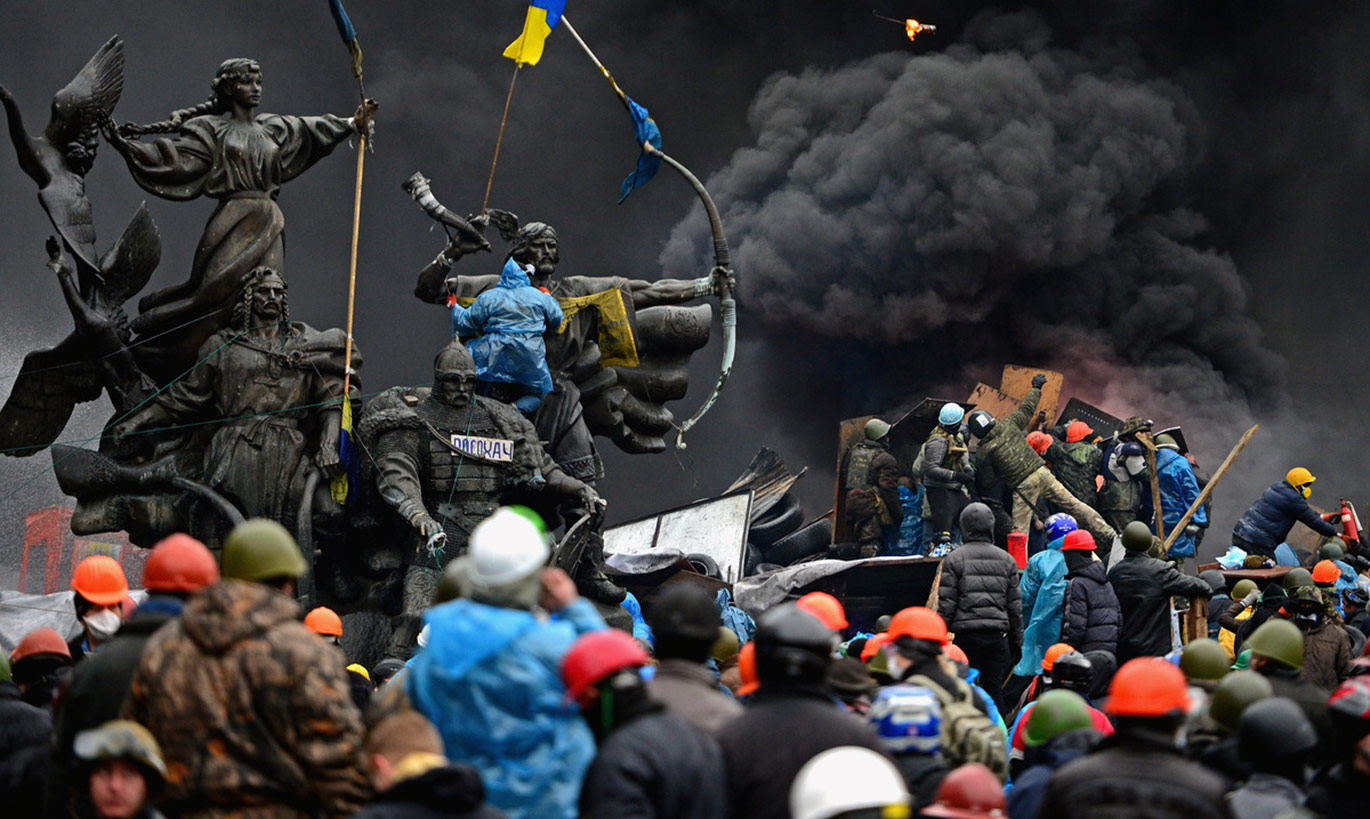
Are they an image from the future?
A few years ago, it was possible to hope that the coming insurrections would be a naturally fertile ground for anarchist resistance. Now it is clear that, although anarchists can find new affinities within them, nationalists can capitalize upon them just as easily. This may be an inherent problem with movements that cohere around tactics, and it poses serious strategic questions to anarchists. Would we have done anything differently in 2011 had we known that we were developing a protest model that fascists could appropriate wholesale?
What had been a purely symbolic conflict over space with Occupy became full-on paramilitary urban warfare in Ukraine. By taking the front lines in confronting the authorities, nationalists and fascists have won themselves legitimacy as “defenders of the people” that will serve them for many years to come. Surely fascists around the world have been watching, and will be emboldened to try the same thing elsewhere when the opportunity arises. Fascists, too, are plugged into a global imaginary; we ignore this at our peril.
But it is not simply a question of fascists emboldening other fascists. The real danger is that the popular imagination about what it means to resist will become militarized—that those who wish to be “effective” will conclude that, like the Ukrainian rebels, they should form hundred-person fighting units with a strict hierarchy of command. We are not opposed to armed confrontation, of course—as we have argued elsewhere, it is essential for any social movement aimed at liberation to be able to push back against the police, and this is rarely pretty in practice. But different formats for confrontation encode different power relations and forms of social change within them. The model we have seen in Kiev opens the way for fascists and other reactionaries to recreate the ruling order within resistance movements—not just by reinserting formal hierarchies and gender roles, but also by confining the substance of the struggle to a clash of armed organizations rather than spreading subversion into every aspect of social relations. Once nationalism is added to this equation, war is not far away.
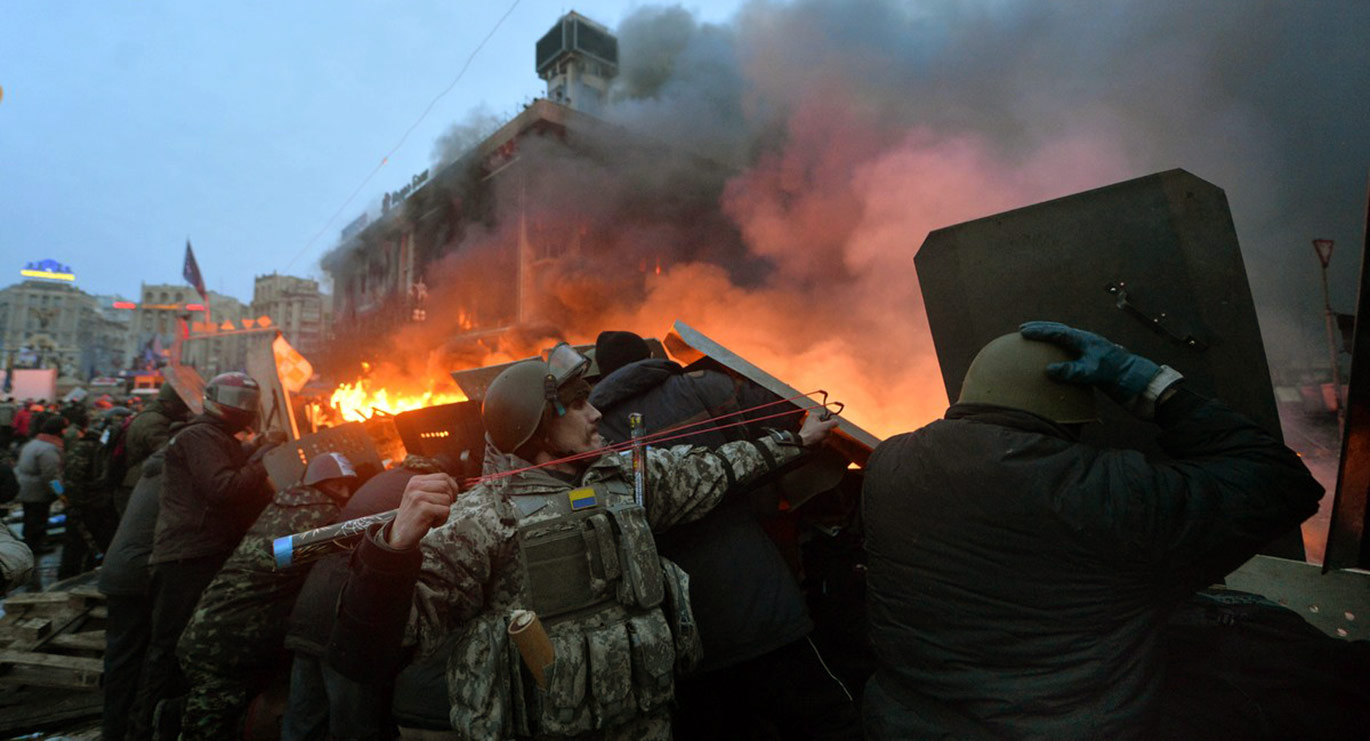
The professionalization of rioting.
The other edge of this sword is that, if burning barricades are branded “fascist,” those who oppose fascism will avoid building them for fear of being misunderstood. We can imagine both fascists and pacifists wishing to promote this misunderstanding. Yet it would not be wise to cede barricade-building to fascists in a time of escalating upheaval.
All this serves to remind us that we are not simply in a conflict with the state in its present incarnation, but in a three-way fight against it and its authoritarian opponents. The present social order will regenerate itself indefinitely until a form of resistance emerges that is capable of overthrowing governments without replacing them. This is not just a contest of arms; it is a clash between different forms of relations. It is not just a struggle for physical territory, but also for tactics and narratives—for the territory of struggle itself.
The movement in Ukraine is not the only one to occur in Eastern Europe; it’s just the most spectacular. It was preceded by tremors in Slovenia, Bulgaria, and elsewhere; more recently, Bosnia erupted, though thankfully most of the participants there explicitly disavowed nationalism. Barring world revolution, the crises inflicted by capitalism will continue to provoke social unrest until the emergence of some massive new mechanism of control or appeasement.
In a globalized world, state structures are forced to impose and perpetuate these crises, but are increasingly powerless to mitigate the effects. This makes the state a sort of hot potato; any party holds the reins at its own risk, as Morsi’s downfall showed in Egypt. On the other hand, in moments of crisis, whoever is capable of effective action against the repressive forces of the state will accumulate popular credibility. This is how our present era is anarchist even where fascists are concerned.
In the case of the Ukrainian revolution, this means that the right-wing Svoboda party could lose their credibility as victory forces them to become the shock troops of neoliberal reform, whereas the more extreme Right Sector could come out ahead, having set a precedent in the streets regardless of how Ukrainians vote in the next election.
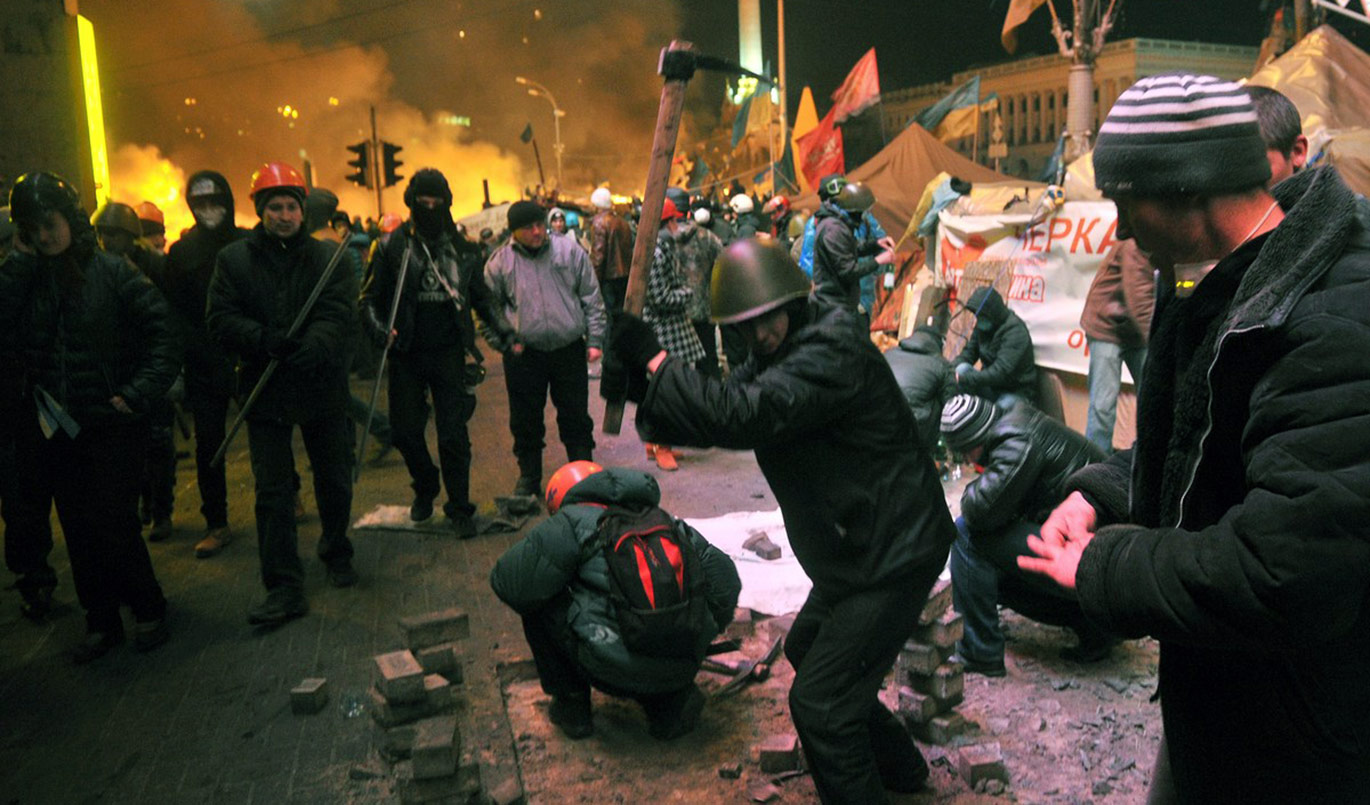
Beneath the paving stones, the counterrevolution.
If the state is a hot potato, it follows that the most important conflicts play out between the antagonists of existing states, not just between them and the state itself. Identifying ourselves, via word or deed, merely as antagonists is not clear enough when we are not the only antagonists of the ruling powers. Our opposition to all hierarchy and domination must be communicated in everything we say and do; otherwise, we risk bolstering a reactionary opposition. Pursuing escalation for its own sake won’t necessarily communicate our politics, nor open a path to liberation; it could even equip our enemies to do the opposite. But avoiding escalation will have even worse consequences.
The fact that these movements can be hijacked by nationalists does not mean that we should remain aloof from them. This was the initial reaction of many anarchists to the plaza occupations in Spain and Occupy in the US, and it could have been disastrous. Standing aside at a moment of popular confrontation with the state permits rival antagonists to seize the initiative, connecting with the general public and defining the stakes. No, we should be there with all we’ve got—for what is at stake in each struggle is never just a single issue, but rather the spirit of opposition itself. We have to be in the front lines if we wish to set the terms of engagement and determine the narrative. For anarchists, that does not mean forming paramilitary organizations, but rather offering points (in space, tactics, and discourse) around which much larger social bodies can cohere according to a logic that challenges both the state and its authoritarian opponents.
We fear that many of our potential comrades will respond to the news from Ukraine by avoiding future confrontations—effectively siding with the preservers of the status quo and leaving the field of struggle to authoritarians. On the contrary, the events in Kiev show what that path leads to.
As far as we can tell from reading the reports, anarchists and others who had avoided the demonstrations were compelled to get involved after all when the stakes were raised to dictatorship or revolution. But at that point, the front lines were dominated by fascists, who attacked anarchists and feminists when they tried to organize under their own banners. So anarchists had to participate on others’ terms, and their contributions may have strengthened a movement from which fascists are deriving new power.
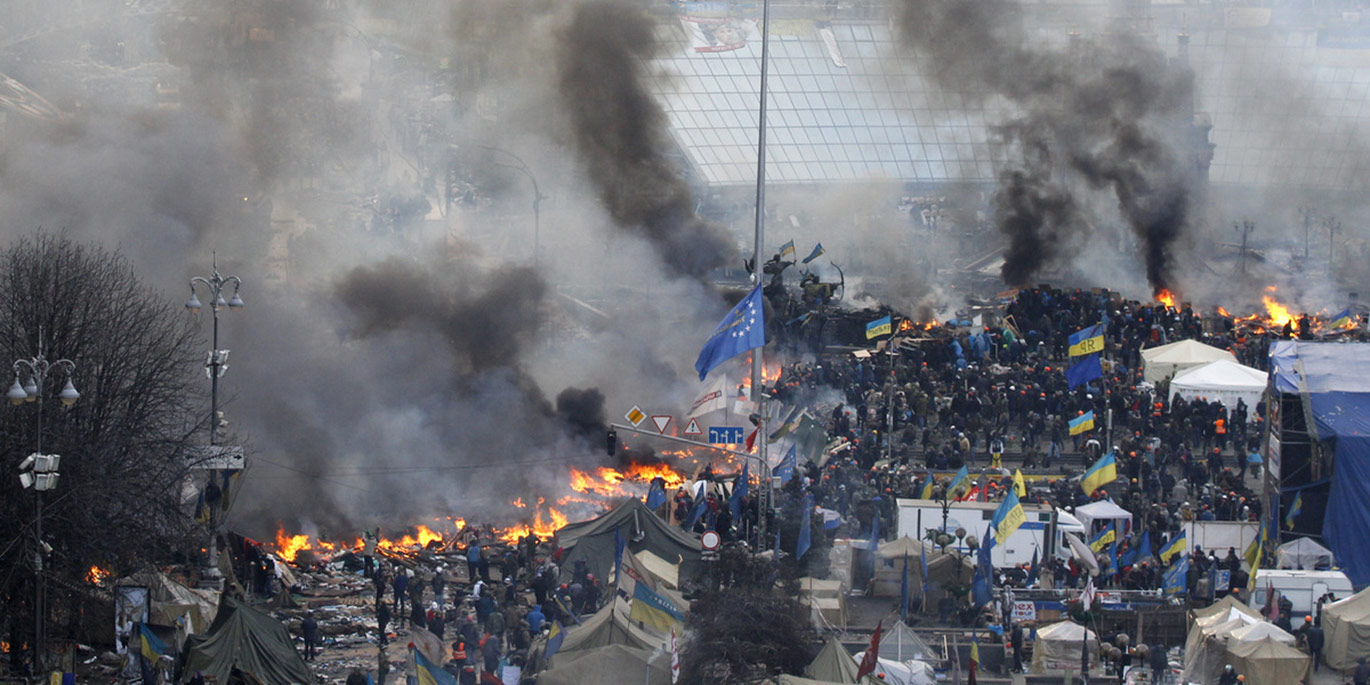
The worst-case scenario.
Of course, different crises offer different opportunities, and Ukraine was a worst-case scenario from the beginning: relatively small anarchist and anti-fascist movements, entrenched nationalist traditions and organizations, and the situation of being torn between authoritarian Russia and the neoliberal European Union. Even if a powerful anarchist movement capable of self-defense had been prepared to show up to the Euromaidan protests from day one, what position could anarchists have taken on the question of trade with the EU without opportunistically violating their principles or gratuitously alienating the rest of the protesters? (To be fair, we have read that Right Sector does not endorse integration into the European Union, either.) If nothing else, this situation drives home the importance of initiating contagious responses to today’s crises on our own terms wherever possible, before history beats us to the punch.
We are not faulting our Ukrainian comrades for how things have turned out. They are doing their best against incredible odds. Rather, we need to understand what has happened in Ukraine so we can be prepared before the next situation like this arises.
If we understand the Ukrainian revolution as part of the same wave of protest that overthrew several governments in North Africa, the tremendous impact of this phenomenon on global politics becomes clear. It is no trivial matter to bring Russia to the brink of war with a nation of 45 million. A variety of capitalists and state actors must be evaluating these protest movements as a way to pursue politics by other means. As more resources flow into the hands of reactionary participants in social struggles, we will likely see more developments like those in Ukraine and Venezuela.
Likewise, powerful governments will not stand by and let common people get a taste for overthrowing them. They will be pressed to intervene, as Russia has in Ukraine, in hopes that war can trump insurrection. War is a way of shutting down possibilities—of changing the subject. It is a risky business, however—it can help governments to consolidate their power, but history shows that it can also destabilize them.

War supplants participatory insurrection with the spectacle of professionalized violence, sidelining the general population.
With war looming, even the limits of violent nationalism become obvious. Mere protest militancy is worthless in the face of the Russian military; only contagious disobedience could serve to even the odds when a social movement does battle with a superpower. This is the one thing anarchist opposition to the state has going for it today: in a globalized world, all insurrections must ultimately become international or perish.
And as long as capitalism produces crises, there are bound to be insurrections.
Strategies for the
Worst-Case Scenario
From this great distance, we have struggled to understand what different strategies Ukrainian anarchists and anti-fascists have employed to make the best of this situation, and what conclusions they have drawn about their effectiveness. We would be grateful to hear more from Ukrainian comrades about this.
We have read about some supposed anarchists and anti-fascists, including the group Narodniy Nabat (“People’s Bell”) and football fans associated with Arsenal-Kiev, who have tried to work alongside nationalist groups in hopes of influencing them or at least getting access to the same public. Such alliances of convenience strike us as a dangerous mistake; the weaker ally is more likely to absorb the logic of the stronger, and to strengthen the position of the stronger ally rather than their own. Though we have heard contradictory assertions about whether groups like “Autonomous Resistance” qualify as nationalists or fascists in the conventional sense, it is clear enough from their gender politics that they are not comrades.
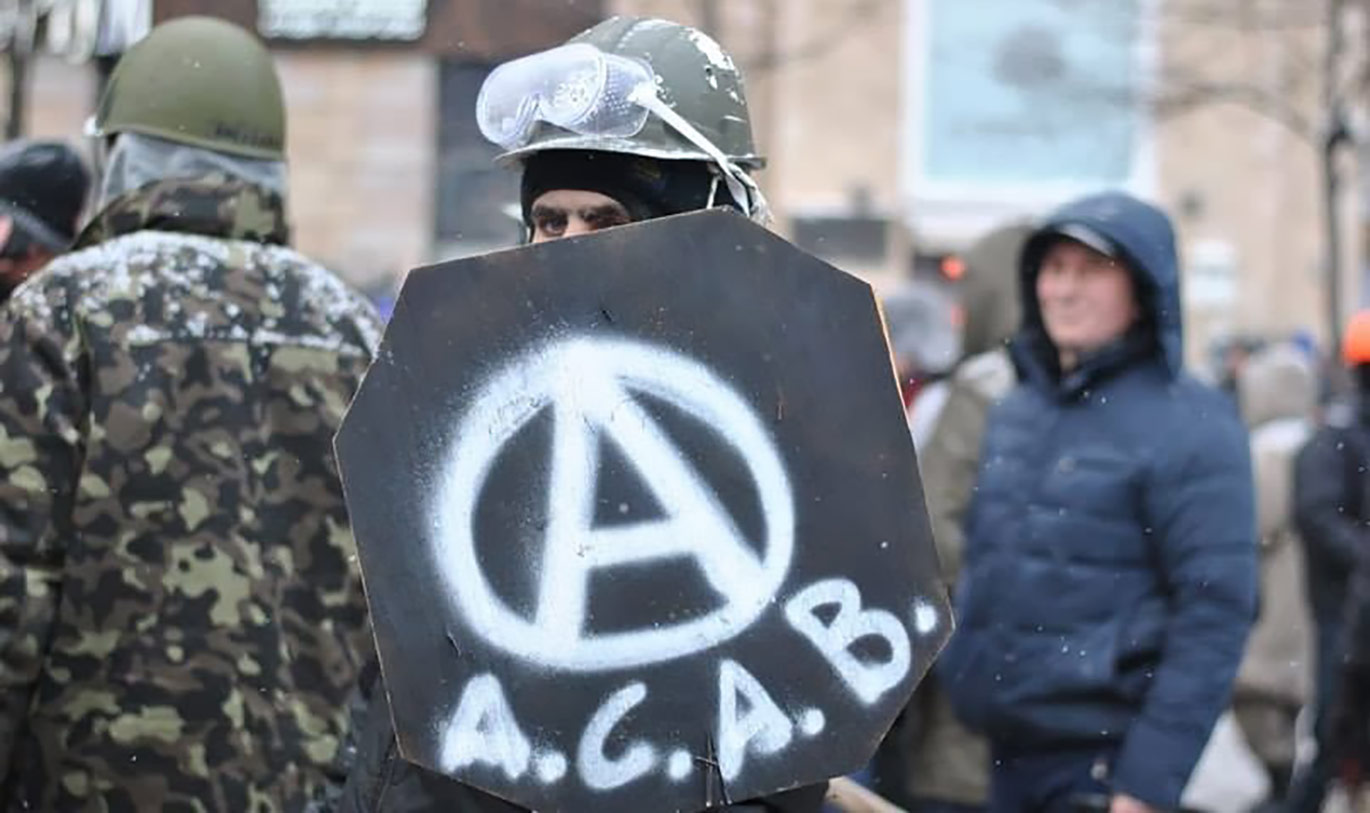
Familiar slogans in ominous company.
At the same time, we agree with one Ukrainian syndicalist that standing aside completely in such contexts can only strengthen the state, and that it is inappropriate to justify this on anti-fascist grounds when there are fascists on both sides of the conflict.
We have read some Ukrainian comrades arguing for the establishment of a separate front of struggle outside the Maidan occupation. As a long-term strategy, this seems sound. But it seems to us that opening another front shouldn’t mean simply falling back on what is familiar—the forms of protest and labor organizing that have been less and less effective over the past century. We doubt that the strategy of workplace organizing will be any more effective in Ukraine than it has been elsewhere around the world since the triumph of capitalist globalization; workers in revolt are increasingly finding one another in the streets, not the workplace. Presumably, the Euromaidan protests have been so successful in part because they are contemporary in the same way that Occupy was: rather than starting from the increasingly unstable foundation of the workplace (or the marginality of subculture), they contested the center of society—literally in urban space, figuratively in political discourse. Any attempt to establish a second front should study what made Euromaidan such an important front in the first place.
Finally, we have heard rumors about anti-fascists who were able to keep fascists out of the protests in Kharkiv. This sounded promising until the newspapers reported that Viktor Yanukovych had fled to Kharkiv—if anti-fascists were able to keep fascists out of the movement only in the parts of Ukraine in which the movement was too small to threaten the government, that is not particularly good news. We await more updates from Kharkiv; it will be especially interesting to hear how anti-fascists are interacting with pro-Russian demonstrators there now.

Grim vistas ahead. Keep your heads up, dear friends.
Reading List:
Some English-Language Sources
Ukraine: A Harsh Antifascist Confrontation Awaits Us—About nationalist violence and cooptation directed at anarchists and antifascists
An Interview with Mira, Andrei, and Sascha of Antifascist Action Ukraine—More background on fascist activity in the movement and attacks on anarchists
Maidan and Its Contradictions: An Interview with a Ukrainian Revolutionary Syndicalist—One of the most detailed sources of anti-authoritarian perspective on these events we’ve been able to find in English
Ukrainian Anarchist Dispels Myths Surrounding Euromaidan Protests, Warns of Fascist Influence—Transcript of an in-depth radio interview on The Final Straw with a member of the Autonomous Workers’ Union, some weeks before the climax of the protests
Euromaidan: A Revolution between the Political Right and the Left—This is not written by comrades, but it offers some interesting background on the relations between the different far-right groups and the left-wing “Narodniy Nabat” (People’s Bell) group that has chosen to fight alongside them; scroll down for English
The Ukrainian Euromaidan: The Solution to Putin, or Just Another Fascist Political Coup?—Thorough background on the statist and fascist interests involved in the Euromaidan protests
Ukraine Riots: “Involuntary Ejaculation of Fire”—An analysis of the causes behind the street confrontations in Kiev in January, 2014
Fifty Shades of Brown—Thoughts on the overthrow of the Yanukovych regime from the Autonomous Workers Union
Lviv 19–21 February 2014—A personal narrative about the developments in Lviv
Readers may also want to consult our recent interview with a member of Kiev’s Autonomous Workers’ Union and our older article about nationalism and behind-the-scenes manipulation of social movements in Serbia: Fake Revolutions, Real Struggles.
Meanwhile, in Venezuela
An interview with Venezuelan anarchists about the protests of 2014, in English translation
